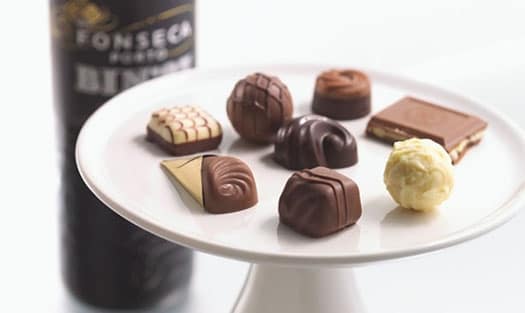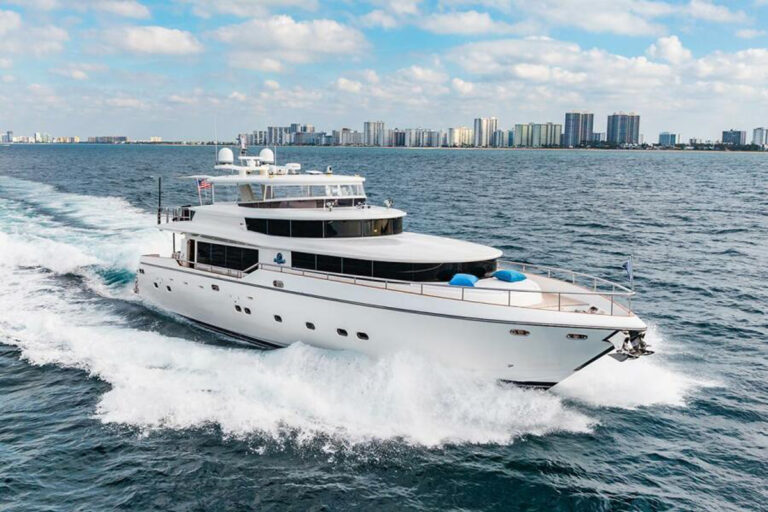
GO LIGHTLY: Fonseca’s Bin 27 is ready to drink, especially with milk chocolates.
In this world there are purists who argue that chocolate needs nothing whatsoever to make it taste any better than it is, as well as those who would say that a glass of port should be enjoyed entirely and completely on its own. The only conclusion to be drawn from this standoff is that, obviously, neither group has ever combined the two.
Savory foods, such as strong cheeses like Roquefort, Stilton, Reblochon, or Epoisses, are wonderfully enhanced by a glass of sweet wine like Sauternes or a German ice wine. And desserts that are not very sweet, like a pound cake or shortbread, are delightful with a whole array of sweet wines, from an oloroso sherry to a fine Madeira.
But when you have a sweetness with as much depth as chocolate, whether it’s enjoyed on its own or in a cake, tart or mousse, you need a drink that can stand up to the sweetness and have the distinctive backbone and tannin that can both buoy and bolster the dessert. Hence port, which also fortunately comes in plenty of styles to match all of those different chocolate desserts.
When I speak of port I speak only of the marvelous, dark-red sweet wines made along Portugal’s beautiful Douro River, whose commercial capital is the city of Porto, as it has been since the 17th century. Port was actually created by British merchants who, finding the wine of the region dark and astringent, began adding a touch of brandy to stop fermentation and stabilize the wines before their sea journey back to England. This is why to this day you find so many British names on port labels, like Croft, Sandeman, Dow, Warre’s and others. Stopping the fermentation of the sugar in the grape juice made for a very sweet wine, but the grape tannins also gave the wine enormous power and richness, not to mention a belt at 20 percent alcohol.
As a result, port became standard issue for officers in the British Navy, with the first toast always to the king or queen and the bottle passed to the left, without touching the table until it’s returned to the captain’s place. Belowdecks the crew got grog.
Along the centuries ports were divided into various styles, from the lightest, called white port, to the young ruby port, the aged tawnies and the very special vintage ports, which are declared only when the vintage is exceptional-about three times in a decade. Sweet red wines in the style of port are made in California and Australia. But two decades ago the Portuguese government made an agreement with the U.S. Bureau of Alcohol, Tobacco and Firearms that Portuguese producers would officially label their wines “porto, while dessert-wine producers in California could continue to use “port. Don’t be fooled: These other products have, in my experience, been far inferior. The good news is that Portugal only ships high-quality ports to the U.S., which buys more vintage port than any other country.
Chocolate’s history, on the other hand, begins in Mexico, where the Aztecs served it to Hernando Cortés, unsweetened and spiced with chile peppers. The Spanish returned to Europe with chocolate beans and, by combining it with sugar, gave rise to one of the most popular beverages of the 17th and 18th centuries, with the chocolate house rivaling the coffee house in social circles.
No one at that time thought of making chocolate into a candy or dessert until Holland’s C.J. Van Houten found a way to release the cocoa butter from the bean. By 1842 Cadbury of England was selling a dark-chocolate candy bar, and in 1875 a Swiss named Daniel Peter added condensed milk and created milk chocolate.
It is cocoa butter that gives premium chocolate its richness of flavor, while cocoa powder is made from a liquid pressed out as “chocolate liquor. Americans have long preferred milk chocolate, while Europeans claim that dark chocolate, which usually does contain a higher percentage of cocoa butter, is superior. To me it is as much a question of taste as it is with port: I love good-quality milk chocolate made by European companies like Suchard, Toblerone and Lindt, just as I love a fine ruby or simple tawny port; at other times I prefer the darker chocolates made by the same companies, and then I tend to tilt more toward 10- and 20-year-old tawnies or a vintage port. But the real pleasures of the marriage of port and chocolate come from desserts, enjoyed at the onboard table with an appreciative friend.
I must admit to a cherished affection for good old American milk chocolate, although I find so many U.S. companies have adulterated their products so as to contain almost no cocoa butter at all. I would never dream of wasting good port with any of them. But as a symbol, I still think Hershey’s Kisses, popped in the mouth with a sip of ruby port, can be utterly, giddily flirtatious.
With good chocolate ice cream or warm cookies, I’d choose a lovely, fruity ruby port, which is uncomplicated, often lighter in body and not too sweet for the milk chocolate. Any of the traditional names like those above will certainly do. A good all-purpose selection with milk chocolate would be Fonseca Bin 27, which is made primarily from a blend of reserve wines from the firm’s own quintas (wineries) and has a great fruit component, with ballast given by four years in oak barrels. It is ready to drink right off the store shelf and does not need decanting.
As the chocolate goes darker and sweeter, so should the ports. This is when I move into the higher-aged tawny category, whose labels may list the year of the average age of the wines in the blend-“10 Year, “20 Year, “30 Year, and “40 Year. Despite their being made from lighter ruby ports, with a characteristic tawny color, aged tawnies are far more complex, with a lovely nutty quality that makes them ideal for dessert time, not only with chocolate but also with fruit desserts like apple pie for instance. Excellent tawnies can be found for between $15 and $20 a bottle.
So, if you were serving a dark-chocolate mousse, rich in egg whites, something like a Cálem 10 Year Old would be perfect. If you were indulging in a dark chocolate soufflé, I’d go perhaps with something a little older, like Graham’s 20 Year Old, which has a depth that will really deliver with the piping hot hazelnut or caramel soufflé.
Late-bottled vintage (LBV) refers to a wine from a single vintage bottled between the fourth and sixth years after the harvest. The distinction between them and a true vintage port is that the latter is declared only about three times in a decade; LBV may come from other years that are not quite so remarkable. An LBV will carry a vintage date. Some are unfiltered and require decanting to remove sediment; these are considered finer than filtered examples. Croft makes consistently good examples, as does Taylor Fladgate. With a serving of the now-ubiquitous soft-centered chocolate cake, which when cut into with a fork releases a liquid chocolate that is downright heady, an LBV would be terrific.
Less than 1 percent of all porto is true vintage, and it therefore has the most prestige and claims the highest price, although even vintage ports are remarkably well priced. These ports all hail from a single vintage made from the finest grapes, blended from several wines, aged for two to three years in barrels, then bottled. The savvy consumer of these marvels knows to wait 10 or even 20 years before opening the bottle and then decanting. (Anyone opening an expensive vintage porto as it comes off the line is naïve, to say the least.) Which is why one can still buy decades-old vintage ports in wine stores for under $100. If, however, you have access to a well-aged vintage porto-at least 15 years old-pull the cork and do as the English demand by tradition: Finish it in one go, with friends, of course.
When you get to this level of port, I think you should consider the wine first, then the chocolate as an accompaniment, in which case I would present a plate of the richest, darkest chocolate truffles I could find. Then I would sit back and watch my sweet take a sip of the vintage port, nibble a morsel of the truffle and watch her swoon-and swoon again.









